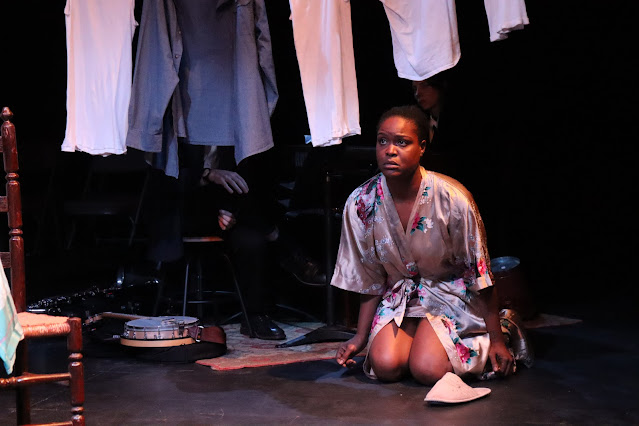How To Eat an Orange
Based on the writing of Claudia Bernardi
66 E 4th St., Manhattan, NYC
May 30-June 16, 2024
 |
| Paula Pizzi. Photo by Steven Pisano |
How To Eat an Orange, making its world premiere at La MaMa, does in fact include a real orange as a prop, and its multifarious symbolizations–evoking at different points cultural specificity, family history, matriarchal inheritance, and even a skull–are representative of the play's boundary-blurring, non-linear presentation of memory. The memories in question belong to visual artist, educator, and activist
Claudia Bernardi, who lived through several years of her native Argentina's military junta, which held power from 1976 to 1983, before departing her country and eventually settling in the United States.
How To Eat an Orange, from Catherine Filloux, a French Algerian American award-winning playwright, librettist, activist, and the co-founder/co-director of
Theatre Without Borders, stars Paula Pizzi as Bernardi in a one-woman production that weaves a moving, associative narrative from Bernardi's experiences that oscillates among innocence, love, and abject cruelty and imagines the separation between the personal and the political and between trauma and reparation to be no greater than that between an orange and its skin.
 |
Paula Pizzi. Photo by Steven Pisano
|
While there is chronological progression built into the show's structure, it works in tandem with a more memorial type of movement, looping back to certain events or feelings or moving in unexpected directions, as when, in the beginning of the show, Bernardi is in fact showing us how she eats an orange when some flowers on her table divert her to childhood memories of her and her sister, Patricia, or Patri, eating citrus blossoms in the belief that it would make them beautiful–an act that also, in their father's admonition to give the flowers a chance to mature into fruit, figures the cutting short of lives and their potential. Mortality, whether or not the result of violence, is, after all, never far away in this play. Losses such as a family member's death inhabit what Bernardi describes as a membrane overstuffed with "the voices, the places, the smells" of her memories, both those that she recounts for the audience–from her run-in as a student with the police after she is robbed and loses the card certifying her "Good Behavior" and days spent living with her grandmother in a household of strong women to Patri's days spent exhuming the mass graves of those "disappeared" by the junta and Claudia's activist art projects in locations from El Salvador to Northern Ireland–alongside those that she will never will speak (the language of silence and silencing recurs several times, as when Bernardi discusses the disappearance of Argentine journalist Rodolfo Walsh). Without undeservedly centering the United States, one of these remembrances includes a clear reminder of this nation's fondness for materially supporting totalitarian regimes, especially in South America.
 |
| Paula Pizzi. Photo by Steven Pisano |
The production features more elaborate set design (by Daniel Landez) than is often the case with single-performer shows, enhancing
Orange's thematic presentation. A large translucent plastic curtain, for instance, which surrounds a table that stands in for an interrogation room, an operating table, and more, not only hints at ominous connotations but also suggests the blurriness of memory when Pizzi performs within it or that above mentioned memorial membrane when she gathers it together in her arms. A crack in the stage similarly suggests both a mail slot and a kind of passage in time/space/memory. Milton Cordero's projection design, which includes use of historical images and footage, works in wonderful complementarity to the set design, as when specific images within a larger projection evocatively play out on a hanging dress. Moving among these images of the past, Pizzi furnishes a confident, poignant performance, artfully conjuring Bernardi at different ages and in different emotional and historical contexts while retaining an awareness of Bernardi as a survivor through even the happy recollections. She also effortlessly summons up distinct others when needed, as in an excellent section about the inception of the forensic anthropology team that began the work of exhumation. Powerful and poetic,
How To Eat an Orange demonstrates not only how our histories haunt us, like the lingering scent of fruit or flowers, and how that haunting testifies to the contingency of our existences–and, more specifically, to how flimsy the barriers to state-sponsored violence actually are, no matter how secure we perceive ourselves to be–but also that it is never too late to seek justice and, as importantly, to bear witness.
-John R. Ziegler and Leah Richards





Comments
Post a Comment